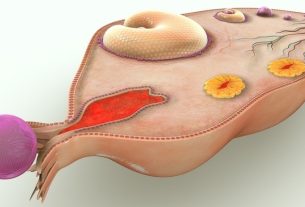Chloasma gravidarum is the appearance of dark spots that appear on the skin during pregnancy, mainly on the forehead, upper lip and nose, and is related to hormonal changes typical of pregnancy.
In some women, it is possible to notice that the characteristic chloasma spots become darker after exposure to the sun without proper protection.
Chloasma gravidarum normally disappears a few months after birth without the need for any treatment, however the dermatologist may recommend the use of some creams during and after pregnancy to prevent the appearance of chloasma, mitigate it or promote its disappearance more quickly.

How to identify chloasma gravidarum
The main characteristics of chloasma gravidarum are:
- Dark spot on the face, especially on the forehead, cheek, nose and upper lip;
- Spot with irregular edge;
- Irregular pigmentation of the stain.
Chloasma gravidarum appears between the first and second trimester of pregnancy and, in some women, it can become more evident when there is sun exposure, which can also make these spots darker.
What is the difference between chloasma and melasma?
Both chloasma and melasma can be characterized by dark spots that appear on the skin, especially on the face. However, chloasma is a type of melasma that only appears during pregnancy. In general, melasma can appear in people who use contraceptives, who have a genetic predisposition or vascular changes, for example. Find out more about melasma.
Why does it appear
Chloasma gravidarum is a typical change during pregnancy that occurs mainly due to the hormonal changes that occur during this period, being mainly related to the increase in the concentration of circulating estrogen.
As a consequence of the increase in estrogen levels, it is possible to stimulate a hormone that acts directly on melanin-producing cells, leading to the appearance of pregnancy spots, including the linea nigra, which is a dark line that can appear on the belly of pregnant women. . See more about the linea nigra.
These spots are more evident in women who are regularly exposed to the sun without proper protection, such as caps, hats or visors, sunglasses and sunscreen, mainly because the sun’s rays can also stimulate the production of this hormone. and thus also favor the emergence of chloasma.
What is the treatment like?
Although chloasma during pregnancy disappears naturally a few months after giving birth, it is recommended that the woman be monitored by a dermatologist, as the doctor will be able to indicate ways to reduce the risk of developing chloasma and lighten the spots, and the use of sunscreen may be recommended. , natural moisturizers and creams with azelaic acid and/or salicylic acid in low concentrations.
After delivery, if there is no improvement in chloasma, the dermatologist may recommend, after the breastfeeding period, the use of some whitening creams or lotions that may contain hydroquinone or retinoids, which should be applied directly to the blemish according to the recommendation. from your doctor, and you are also advised to avoid exposure to the sun to avoid causing more blemishes.
Furthermore, after the breastfeeding period, the doctor may recommend carrying out some aesthetic procedures that can also promote the elimination of blemishes, such as peeling, laser treatment and microdermabrasion, for example.
See the video below for more tips on what to do to eliminate blemishes on your face:

Sign up for our newsletter and stay up to date with exclusive news
that can transform your routine!
Warning: Undefined array key "title" in /home/storelat/public_html/wp-content/plugins/link-whisper-premium/templates/frontend/related-posts.php on line 12
Warning: Undefined array key "title_tag" in /home/storelat/public_html/wp-content/plugins/link-whisper-premium/templates/frontend/related-posts.php on line 13




